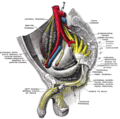Talk:Iliacus muscle
| This article is rated C-class on Wikipedia's content assessment scale. It is of interest to the following WikiProjects: | ||||||||||||||
| ||||||||||||||
Removed unreferenced content
[edit]I removed the following sections from the article because they lack references. --Addingrefs ( talk | contribs ) 17:41, 4 June 2009 (UTC)
| “ | It arises from the upper two-thirds of this fossa, and from the inner lip of the iliac crest; behind, from the anterior sacroiliac and the iliolumbar ligaments, and base of the sacrum; in front, it reaches as far as the anterior superior iliac spine and anterior inferior iliac spine, and the notch between them.
The fibers converge to be inserted into the lateral side of the tendon of the Psoas major, which contributes to flexing the femur anteriorly onto the pelvis. Some of the iliacus fibers may reach the body of the femur, for about 2.5 cm. below and in front of the lesser trochanter. The Iliacus is sometimes considered a part of the Iliopsoas group of hip flexor muscles. This muscle is innervated by the anterior branches of the Femoral nerve (anterior branches of L2-3). Working synergistically with the Psoas in gait (walking) and evaluation for low back pain, careful attention is placed on the slightly different spinal innervation from L4 with the psoas and a more horizontal action (leg further out). |
” |
Removed gallery
[edit]I also removed the following gallery because most of the images are off-topic imho (and per Wikipedia:IG#Image galleries). --Addingrefs ( talk | contribs ) 17:41, 4 June 2009 (UTC)
-
Sacrum, pelvic surface.
-
Right femur. Posterior surface.
-
Structures surrounding right hip-joint.
-
Muscles of the iliac and anterior femoral regions.
-
The abdominal aorta and its branches.
-
Structures passing behind the inguinal ligament.
-
The relations of the femoral and abdominal inguinal rings, seen from within the abdomen. Right side.
-
The lumbar plexus and its branches
-
Nerves of the right lower extremity. Front view.
-
Sacral plexus of the right side.
-
Posterior view of the anterior abdominal wall in its lower half. The peritoneum is in place, and the various cords are shining through.
Rotation
[edit]This is not mentioned under actions, but based on the line of pull, it looks like this muscle would work to rotate the thigh as the psoas does. Is this something we could add or mention to the page? Dictabeard (talk) 23:07, 3 March 2011 (UTC)
External links modified
[edit]Hello fellow Wikipedians,
I have just modified one external link on Iliacus muscle. Please take a moment to review my edit. If you have any questions, or need the bot to ignore the links, or the page altogether, please visit this simple FaQ for additional information. I made the following changes:
- Added archive https://web.archive.org/web/20100715211225/http://www.ptcentral.com/muscles/musclelegs.html to http://www.ptcentral.com/muscles/musclelegs.html
When you have finished reviewing my changes, you may follow the instructions on the template below to fix any issues with the URLs.
This message was posted before February 2018. After February 2018, "External links modified" talk page sections are no longer generated or monitored by InternetArchiveBot. No special action is required regarding these talk page notices, other than regular verification using the archive tool instructions below. Editors have permission to delete these "External links modified" talk page sections if they want to de-clutter talk pages, but see the RfC before doing mass systematic removals. This message is updated dynamically through the template {{source check}} (last update: 5 June 2024).
- If you have discovered URLs which were erroneously considered dead by the bot, you can report them with this tool.
- If you found an error with any archives or the URLs themselves, you can fix them with this tool.
Cheers.—InternetArchiveBot (Report bug) 23:43, 11 November 2017 (UTC)










